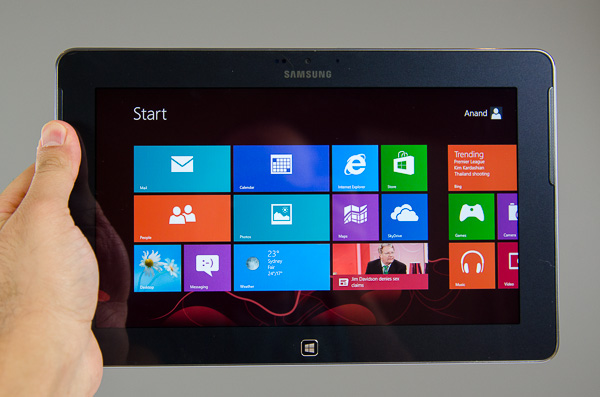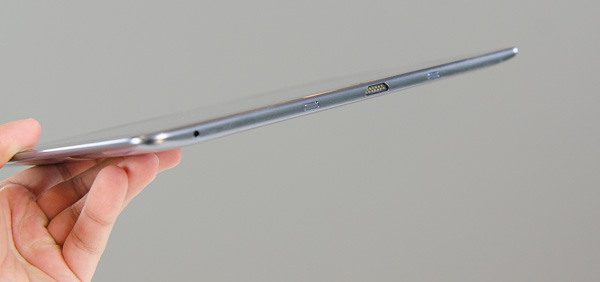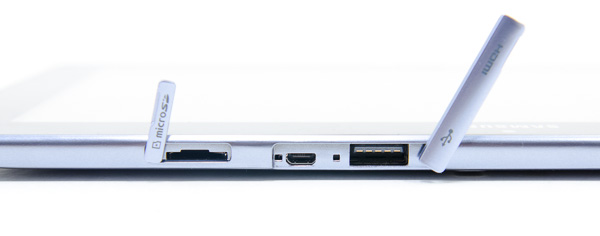Samsung ATIV Tab Review: Qualcomm's First Windows RT Tablet
by Anand Lal Shimpi on January 3, 2013 6:00 AM EST- Posted in
- Tablets
- Samsung
- Qualcomm
- Mobile
- Windows RT
I remember writing Intel and telling them that, from a tablet perspective, the Windows 8 launch might as well have been a Windows RT launch. By the time October 23rd rolled around, the only Windows tablets we had in for review were ARM based and running Windows RT. I even resorted to borrowing an unfinished Clover Trail tablet just so we’d have something to put Surface RT’s performance in perspective at launch.
Clover Trail was late by about a month to the Windows 8 launch. Most of the traditional PC partners were delayed either by Intel or by burdens of their own. As much as we wished Surface RT would’ve launched with a different SoC, truth be told I don’t know that anyone else outside of NVIDIA could’ve met the aggressive schedule that Microsoft set. Qualcomm and TI were both design partners working on Windows RT devices, but neither of them had solutions available at launch.
Now that we’re two months out from launch however, things are starting to change. We’ve already reviewed one of the first Clover Trail tablets, with another on the way. And just before the holidays last year, this thing showed up:
It may look like the Samsung ATIV Smart PC that Vivek is working on, but it’s the smaller 10.1-inch ATIV Tab featuring Qualcomm’s APQ8060A SoC. Yep, this is the first Windows RT tablet we have in house to use Qualcomm silicon.
In the phone space, Qualcomm’s Krait based SoCs have generally been the preferred platform. Using TSMC’s 28nm LP process, they’ve offered better power consumption than NVIDIA’s 40nm LPG Tegra 3. The 2 Krait cores housed in the more popular of these SoCs (MSM8960), at least in phones, generally delivered better performance than the NVIDIA alternative as well. But that was in the Android space - would things be any different on a Windows RT tablet? With an inherently more multitasking friendly device and OS, would NVIDIA’s quad-core approach trump Qualcomm’s pair-of-faster-cores? And what about battery life? Tegra 3 did remarkably well in Surface RT, but how would Qualcomm fare?
Armed with Samsung’s ATIV Tab, I tried to find out.
The Tab
As with most of Samsung’s tablet designs, the ATIV Tab is a tablet built out of plastic and glass. The design and feel aren’t bad, but they’re nothing particularly new or exciting. The big benefit of the plastic chassis is of course weight. The ATIV Tab weighs in at 572g compared to 688g for Surface RT, it’s around the same weight as the Acer W510 we reviewed a couple of weeks ago. The light weight means carrying it around is quite pleasant. And despite the plastic construction, build quality is solid. I noticed no creaks or unsettling flexibility in the chassis.
Internally there's a Qualcomm APQ8060A SoC (dual-core Krait running at up to 1.5GHz + Adreno 225, no integrated baseband) paired with 2GB of LPDDR2 memory. It is a bit surprising that Samsung/Qualcomm didn't opt to launch with APQ8064 (quad-core Krait), but I suspect this was a decision made more out of time to market than anything else.

On the storage side there's either a 32GB or 64GB eMMC solution soldered down on the board. Remember that Windows RT comes preinstalled with a full version of Office 2013 Home & Student Edition. After Samsung's preinstalled apps a 32GB ATIV Tab shows up with around 14.1GB of free space.
The ATIV Tab’s 10.1-inch 1366 x 768 display makes for a familiarly portable form factor. While the Smart PC’s 11.6-inch form factor makes for a better notebook, the ATIV Tab seems to be a better tablet.
Like the Clover Trail version, the ATIV Tab is littered with plastic doors over nearly every port around the perimeter of the device. Along the top the micro HDMI and full USB 2.0 port are behind a door, as is the microSD card slot. The doors do help maintain a smooth edge, but I’m not a fan of them.
Headphone jack, power/lock and volume up/down are also along the top of the tablet. There's no rotation lock button on the ATIV Tab. There's a physical Windows button on the front face of the tablet.
The sides are devoid of any intrusions into the ATIV Tab’s design, while the bottom edge features the charge port as well what looks like a dock connector. My review sample didn't come with a dock and Samsung's website doesn't seem to list any keyboard dock accessory for the ATIV Tab, so for now this port goes unused.
There are a pair of reasonably loud (for a tablet) stereo speakers that border the display, while front (1.9MP) and rear (5MP) cameras complete the package for Samsung.
| Tablet Specification Comparison | ||||||||
| Samsung ATIV Tab | Apple iPad 4 | Google Nexus 10 | Microsoft Surface RT | Samsung ATIV Smart PC | ||||
| Dimensions | 10.46 x 6.62 x 0.35" | 9.5 x 7.31 x 0.37" | 10.39 x 6.99 x 0.35" | 10.81 x 6.77 x 0.37" | 11.97 x 7.46 x 0.39" | |||
| Display | 10.1-inch 1366 x 768 IPS | 9.7-inch 2048 x 1536 IPS | 10.1-inch 2560 x 1600 PLS | 10.6-inch 1366 x 768 PLS | 11.6-inch 1366 x 768 PLS | |||
| Weight | 1.26 lbs | 1.44 lbs (WiFi) | 1.33 lbs | 1.5 lbs | 1.64 lbs | |||
| Processor | Qualcomm APQ8060A (2 x 1.5GHz Krait, Adreno 225) |
Apple A6X (2 x Swift, PowerVR SGX 554MP4) |
Samsung Exynos 5 Dual |
NVIDIA Tegra 3 |
Intel Atom Z2760 (2 x 1.8GHz Atom, PowerVR SGX 545) | |||
| Connectivity | WiFi | WiFi , Optional 4G LTE | WiFi | WiFi | WiFi , Optional 4G LTE | |||
| Memory | 2GB | 1GB | 2GB | 2GB | 2GB | |||
| Storage | 32-64GB | 16GB—64GB | 16GB or 32GB | 32GB or 64GB | 64GB | |||
| Battery | 30.0Wh | 42.5Wh | 33.75Wh | 31.5Wh | 30.0Wh | |||
| Starting Price | $499? | $499 | $399 | $499 | $599 | |||
The more I use other Windows RT/8 tablets, the more I'm realizing that the stability issues I encountered with Acer's W510 are more a function of that tablet and less a general Microsoft problem. Although I did experience a couple of unexpected app crashes, the overall experience with Samsung's ATIV Tab was positive. I didn't see anywhere near the number of cases of strange behavior as I did with the W510. I'm beginning to wonder if Clover Trail's Windows 8 software stack isn't as mature as the Windows RT implementations that I've played with.














42 Comments
View All Comments
kyuu - Thursday, January 3, 2013 - link
"I suspect that once we get to the next generation of SoCs we'll see a better story from all of the vendors (22nm Atom, Cortex A15 based Wayne, Krait 200/300 from Qualcomm)."You seem to have forgotten about AMD's upcoming Temash tablet SoC. That's the one I'm looking forward to the most. Heck, I'd take the AMD's Hondo Z-60 over Clover Trail even today, if there were any tablets actually using it.
mayankleoboy1 - Thursday, January 3, 2013 - link
40nm Temash will be power hungry. It will probably have great GPU performance, but the battery life will be crappy. There is a limit on how many transistors you can add on 40nm. :(Death666Angel - Thursday, January 3, 2013 - link
Anandtech said they will be 28nm, so unless things have changed (in which case a link would be nice) they should be competitive.OoklaTheMok - Thursday, January 3, 2013 - link
Anand, the way you mentioned lack of a rotation lock on the ATIV Tab seems to indicate that there isn't a way to lock the screen rotation. Rotation lock is controlled via software @ Charms Bar > Settings > Screen. You likely know this already, but other readers may come away thinking that Win 8/RT lacks a rotation lock.Thank you for your great review as usual. I always love the details you provide.
powerarmour - Thursday, January 3, 2013 - link
So where are the Adreno GPU tests?, how do the drivers perform in DirectX...Talk about half a review!
Ananke - Thursday, January 3, 2013 - link
Anything that cost equal or more than iPad is a marketing joke, and it wont sell well - it is that simple. I don't like Apple products at all, but once considering all the available applications, accessories, future support by even more applications, etc. there is no reason to spend the same money on something else than iPad. For the non-i fans there is Android already.RT is already dead dog, for retail. It did have its several months of prime time, but the time is gone now...
Saying all of this while owning MS W8 desktops, laptops, and phones.
My ex-MS developer friends, that are now all Android developers, say they no more are interested or intend to move back to MS - it is just not worth developing for a very limited user base. Overpricing of RT doesn't help either.
Visual - Thursday, January 10, 2013 - link
It will sell if it runs Crysis.ImSpartacus - Thursday, January 3, 2013 - link
Page 2"This test uses using AES for security."
MonkeyPaw - Thursday, January 3, 2013 - link
How is it when I run Kraken on my TF700T running Jelly Bean and Chrome, I score 22053? Is it hardware, Android or Chrome making the difference? That handily defeats all the Windows 8 tablets unless I'm missing something.Klimax - Friday, January 4, 2013 - link
Benchmark specific optimisation in Chrome most probably. (After SunSpider IE team apparently stopped paying attention to them) Also those benches are often written by browser vendors themselves and for their internal usage and thus originally targeted at their own browser reducing value of that for other browsers. (Testdrive, Kraken, Octane,...)BTW: Comment form doesn't post under IE10 with compatibility mode off.